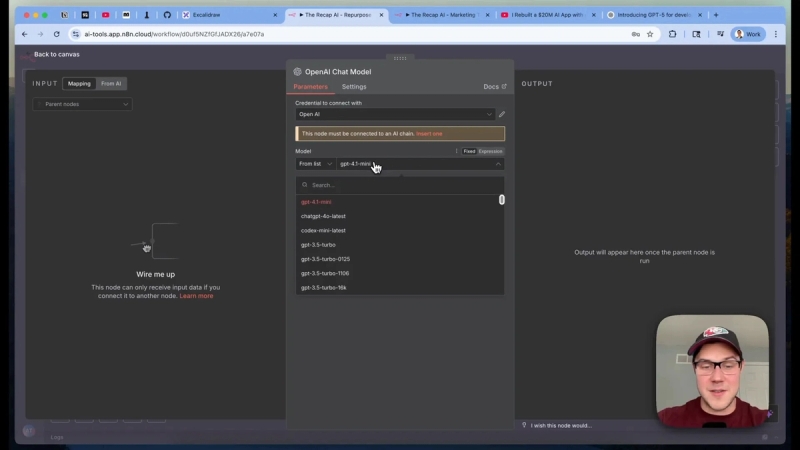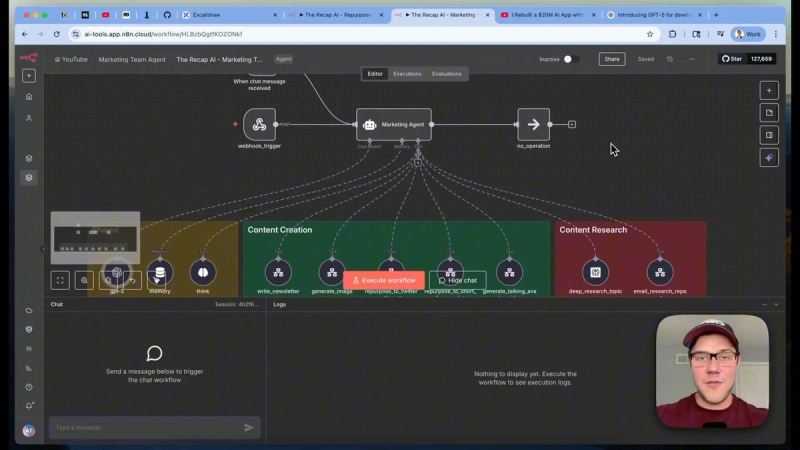OpenAI has just released GPT-5, their most advanced AI model to date. But rather than simply testing it in a chat window, I put GPT-5 to work inside actual AI agents powering our content and marketing workflows. This hands-on comparison pits GPT-5 against Gemini 2.5 Pro and Claude Sonnet 4, running live production-grade tasks. The goal? To see which model truly delivers the best performance in real business use cases.
If you want to build smarter AI-powered automations or agents for your business, joining our free AI Automation Community is a great way to get access to proven workflows and expert guidance.
Setting Up GPT-5 in Our AI Automation Platform
The first step to testing GPT-5 was integrating it into our automation platform, which uses the n8n workflow automation tool. Our AI agents rely on n8n to orchestrate tasks like writing newsletters, creating social media posts, and generating video scripts.
To set up GPT-5, I added the OpenAI chat model node inside the workflow editor. After connecting my OpenAI API key, I selected GPT-5 from the model dropdown. If GPT-5 doesn't appear, you can manually enter the model's ID as listed on OpenAI's developer announcement page, including variants like GPT-5 Mini or GPT-5 Nano for faster responses.

This setup enabled GPT-5 to replace the previous models powering our automations. The process was straightforward and required no changes to the existing prompts or workflow logic, allowing for a pure comparison of model capabilities.
Content Repurposing: GPT-5 vs Claude Sonnet 4
One of our key automations repurposes YouTube video transcripts into social media posts optimized for engagement. This workflow takes a video URL, scrapes the transcript, and generates two types of posts:
- An engagement-focused Twitter post
- An engagement-focused LinkedIn post
Both posts follow example templates in the prompts to guide style and tone. Previously, this workflow used Claude Sonnet 4. I swapped in GPT-5 without changing prompts or workflow nodes to compare outputs side-by-side.
Here’s what stood out:
Twitter Post
Claude Sonnet 4’s tweet focused on an AI nutrition analyzer app, which was off-topic from our actual video content about workflow automation. It followed the prompt format but missed the core message we wanted to promote.
GPT-5, on the other hand, crafted a tweet highlighting the scale of apps like Calorie AI, tying it directly back to our workflow breakdown video. This made GPT-5 the clear winner for Twitter content as it better understood the goal.
LinkedIn Post
For LinkedIn, Claude Sonnet 4 produced a more concise and cohesive post with a strong hook that aligned well with LinkedIn’s professional tone. GPT-5’s output was longer and somewhat verbose, including unnecessary details like “hiccups” that didn’t add value.
Here, Claude Sonnet 4 edged out GPT-5 for LinkedIn due to clearer, more targeted messaging and better post length.
Overall, GPT-5 won for Twitter repurposing but lagged slightly behind Claude Sonnet 4 on LinkedIn post quality.
Upgrading Our AI Marketing Agent with GPT-5
Next, I upgraded our marketing team’s AI agent, which was previously powered by Gemini 2.5 Pro, to GPT-5. This agent handles complex workflows including writing newsletters, generating images, creating social media threads, and producing video scripts—often calling multiple tools and relying heavily on memory.
Replacing Gemini 2.5 Pro with GPT-5 was simple: I swapped out the chat model node in n8n and reconnected the agent to GPT-5.

Here are the key areas I tested:
Writing the Newsletter
I asked the agent to write the day’s newsletter edition. GPT-5 correctly checked memory first for existing content and then called the newsletter writing tool without unnecessary retries or errors. This was an improvement over Gemini 2.5 Pro, which sometimes redundantly retried writing the newsletter.
Generating Images
For image generation, GPT-5 successfully called the image tool four times—once for each core newsletter section. It slightly overestimated by including two extra sections, but this didn’t break the flow and demonstrated good tool integration.
Repurposing Content to Twitter Threads
When asked to create a Twitter thread promoting the newsletter’s top story, GPT-5 loaded the content from memory and generated a relevant thread without hallucinating or misusing tools. Gemini 2.5 Pro had issues in the past with mistakenly rewriting newsletters during this step.
Creating Short-Form Video Scripts
GPT-5 repurposed the newsletter content into a short-form video script. An edge case caused a tool failure, but GPT-5 recovered by reloading information from memory and completing the script. This demonstrated self-correction capabilities, though some guardrails might be needed to prevent such fallback behavior.
Handling Multi-Tool Commands
Finally, I tested GPT-5’s ability to execute a multi-step command: researching a topic deeply and emailing a report. GPT-5 correctly called the research tool, then passed the results to the email tool, completing the task as expected.
This complex workflow requires coordination between many tools and persistent memory over the day. GPT-5’s first attempt was highly successful, while Gemini 2.5 Pro struggled with tool selection and memory consistency, often wasting tokens and time.
Performance and Latency Considerations
One downside to GPT-5 was its slower response time compared to Gemini 2.5 Pro and GPT-5’s own smaller variants like Mini and Nano. On launch day, GPT-5’s latency was noticeably higher during content generation tasks, likely due to heavy demand.
For workflows where speed is critical, such as voice agents or real-time interactions, Gemini 2.5 Pro or lighter models might still be preferable. However, for complex, multi-tool automations where accuracy and memory usage matter most, GPT-5 offers clear advantages.
Summary of Model Strengths
- GPT-5: Excels in understanding context, memory usage, and complex tool orchestration. Best for Twitter content and advanced AI agents.
- Claude Sonnet 4: Produces concise, well-structured LinkedIn posts with strong hooks. Better for professional social media content.
- Gemini 2.5 Pro: Faster latency, suitable for low-latency applications, but weaker in memory consistency and tool management.
Get Started with AI Automation
Whether you want to build AI marketing agents, automate content repurposing, or integrate multiple AI tools into your workflows, choosing the right model is crucial. GPT-5 shows strong promise as the brain behind complex AI systems, but understanding its latency and cost implications is important.
If you want to dive deeper into building AI-powered workflows and agents like these, consider joining our AI Automation Mastery community. You’ll get access to ready-made automations, expert tips, and a network of entrepreneurs using AI to grow their businesses.





